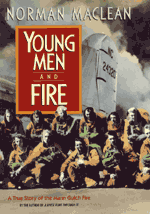The history of young men and fire

Sixty years ago today, a crew of fifteen of the United States Forest Service’s elite airborne firefighters, the Smokejumpers, stepped into the sky above a remote forest fire in the Montana wilderness. Two hours after their jump, all but three of these men were dead or mortally burned.
One of those three survivors, Bob Sallee, will speak to the public this week in Montana as part of ceremonies held to observe the anniversary of the conflagration.
Sallee, of course, also figures prominently in Norman Maclean’s Young Men and Fire, which hauntingly searches out and fits together the scattered pieces of the Mann Gulch tragedy.
In this evocative excerpt, Maclean reflects on how it was that of the crew only Rumsey and Sallee survived.
If you had known ahead of time that only two would survive, you probably never would have picked these two—they were first-year jumpers, this was the first fire they had ever jumped on, Sallee was one year younger than the minimum age, and around the base they were known as roommates who had a pretty good time for themselves. They both became big operators in the world of the woods and prairies, and part of this story will be to find them and ask them why they think they alone survived, but even if ultimately your answer or theirs seems incomplete, this seems a good place to start asking the question. In their statements soon after the fire, both say that the moment Dodge reversed the route of the crew they became alarmed, for, even if they couldn’t see the fire, Dodge’s order was to run from one. They reacted in seconds or less. They had been traveling at the end of the line because they were carrying unsheathed saws. When the head of the line started its switchback, Rumsey and Sallee left their positions at the end of the line, put on extra speed, and headed straight uphill, connecting with the front of the line to drop into it right behind Dodge.